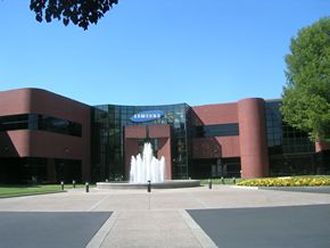 Tablet makers are set to roll out the next generation of cheaper tablets over the coming weeks and it is now clear that competition in the cutthroat market will intensify in the second half of the year.
Tablet makers are set to roll out the next generation of cheaper tablets over the coming weeks and it is now clear that competition in the cutthroat market will intensify in the second half of the year.
HP launches all singing data centre network fabric
 HP has introduced a data centre network fabric built on its FlexNetwork architecture.
HP has introduced a data centre network fabric built on its FlexNetwork architecture.
The company claims its new baby will give business agility for clients by delivering two times greater scalability and 75 percent less complexity over current network fabrics.
It also claims clients could also see a reduction in network provisioning time from “months to minutes”. A bold claim, indeed.
As companies move to a cloud environment, legacy network architectures are apparently buckling under the pressure for instant access to applications and services .
HP also said organisations are struggling with the complexity of current data centre network fabric designs, which need manual device-by-device configurations and limit the performance of bandwidth-intensive applications.
It said it was moving to save the network world with a series of software-defined network (SDN) data centre switches that are claimed to deliver advanced automation capabilities and industry-leading scalability for bandwidth-intensive applications such as Hadoop.
The offerings include the HP FlexFabric 12900, which is an OpenFlow-enabled core switch capable of scaling to meet the demands of virtualised workloads.
By simplifying network design and operations, HP’s new networking products are claimed to enable customers to improve IT productivity by unifying the virtual and physical fabric with new HP FlexFabric Virtual Switch 5900v software. In conjunction with the HP FlexFabric 5900 physical switch, this is said to deliver advanced networking functionalities such as policies and quality of service to a VMware environment.
Integrated Virtual Ethernet Port Aggregator (VEPA) technology provides clear separation between server and network administrations to deliver operational simplicity.
It is also claimed to reduce data centre footprint with the HP Virtualized Services Router (VSR), which allows services to be delivered on a virtual machine (VM), eliminating unnecessary hardware.
The scale data centre fabric for improved application performance is claimed to enhance support for complex, high data-consuming applications with the HP FlexFabric 12900 switch series, which manages bandwidth spikes with the built-in networking standard Transparent Interconnection of Lots of Links (TRILL).
The HP FlexFabric 12900 switch series can apparently move up to three times more data across the network per 40-gigabit Ethernet port.
Alongside all the new frill, HP has said its Technology Services could help customers evolve and operate complex data centre networks to reallocate resources to innovation and business growth. It’s new services include the HP Connectivity Transformation Experience Workshop, which is claimed to help customers achieve network scale and agility with a defined strategy for network transformation that aligns business and IT goals.
Its IPv6 Roadmap Service also provides access to experienced consultants to develop a transition roadmap to IPv6 by considering all six of the domains affected by this transition, while the HP Datacenter Care for Networking is said to offer a single point of contact for reactive support and proactive services that enable customers to quickly resolve network
issues.
HP will demonstrate the new data center products and services in the HP FlexNetwork architecture at Interop Las Vegas, held May 6-10 at Mandalay Bay, in booth 1527.
M-commerce continues to wow shoppers
 M-commerce is continuing to grow in the retail space, a report has suggested.
M-commerce is continuing to grow in the retail space, a report has suggested.
In its Online Retail Index IBM said that the new way to spend money has been growing in popularity with smartphone owners opting to use this over traditional means of shopping.
According to the report, mobile commerce grew by 31 percent in the first quarter of this year, up from the same time in 2012. It said the technology now accounted for 17.4 percent of all online retail sales. The figures were also up from 13.3 percent in the year-earlier period.
IBM said that the trend had grown as a result of many shoppers liking the freedom m-commerce offered, enabling them to shop more frequently and, in some cases, spend more money. It also pointed out that the growth of interactive technologies, such as augmented reality and QR codes, which offered discounts for shoppers using m-commerce sites, had helped boost the adoption of mobile commerce.
And tablets have also fuelled the shopping frenzy, with IBM noting this technology’s larger screens, navigation and easier touch functions made online shopping easier.
IBM said that the growth would continue as a result of retailers embracing the trend and offering their customers sites that catered for m-commerce.
Education hardware sees growth
 Education hardware spend grew in 2012.
Education hardware spend grew in 2012.
According to Futuresource Consulting, the sector saw an increase of 23 percent to a total spend of $11.6 Billion, from 2011.
The analyst company said this was a strong result compared to other markets and considering the pressure on education budgets across the world.
Looking to the future, the company predicted that the total value is expected to reach $21 billion by 2017, a CAGR of 12 percent from 2012 to 2017.
It also claimed that as well as raking in the cash the education sector was slowly moving digital, potentially opening up a wide range of revenue stream opportunities in hardware, software, content, infrastructure and services for suppliers.
This increase of spend in education technology has been driven by the uplift in the mobile PC market, which at $6.8 billion, now accounts for 59 percent of the total spend, up from 51 percent.
The explosion of tablets and ‘one to one learning programmes’ primarily driven by the iPad and now the iPad mini, are also expected to accelerate growth in 2013.
And traditional education tools are also helping fuel revenue. In 2012, a million interactive board displays were sold, marking an annual increase of 15 percent the company said.
The interactive projector market is also expected to have some of the greatest growth in the classroom technology market, with a 2012 – 2017 volume CAGR of 19 percent.
Best Buy to sell European op to Carphone Warehouse
 Best Buy has decided to unload its 50 percent share in Best Buy Europe to its joint venture partner Carphone Warehouse in a deal valued at £500 million.
Best Buy has decided to unload its 50 percent share in Best Buy Europe to its joint venture partner Carphone Warehouse in a deal valued at £500 million.
Under the terms of the agreement, Best Buy will receive £420 million in cash and £80 million in Carphone Warehouse stock, subject to a 12-month lock-up restriction. Best Buy also agreed to pay Carphone Warehouse £29 million to settle obligations stemming from existing agreements, some of which will be terminated when the outfits close the deal.
The transaction has already been approved by the boards of both companies and it should be finalized by June 2013.
“After reviewing the business and spending time with our partners, we concluded that the timing and economics were right to enter into this agreement with CPW,” said Hubert Joly, president and chief executive officer of Best Buy.
Joly went on to say that the transaction will allow Best Buy to simplify its business, improve its return on invested capital and strengthen its balance sheet.
“Each international market is different and the sale of our European operations should not suggest any similar action in our other international businesses,” said Joly.
The joint venture was launched in 2008, with Best Buy paying $2.15 billion for its share of Best Buy Europe.
Huawei boss in leaked letter: no-go for IPO
 Huawei CEO Ren Zhengfei has said in an internal note sent Sunday, and seen by Reuters, that the company will not go public in the next decade – and the incumbent CEO will not be related to Ren.
Huawei CEO Ren Zhengfei has said in an internal note sent Sunday, and seen by Reuters, that the company will not go public in the next decade – and the incumbent CEO will not be related to Ren.
The boss of the humongous equipment manufacturer said that Huawei will not be going public in the next five to ten years, and plans to avoid entering capital markets. “We have not studied the issue of an IPO because we feel that listing is not conducive for our development,” he wrote.
In the letter, Ren also noted that his family won’t be taking his place when he steps down: “Huawei’s successor should not only have vision, character and ambition, like what we’ve said before, but also a good global perspective and the acumen to drive the business. My family members do not possess these qualities. Thus, we will never be in the running of the successor race.”
Both Ren’s son and and daughter have jobs at Huawei, however, they are not part of the CEO system that was created for when the chief exec steps down. Three big wigs at the company – deputy chairs Ken Hu and Guo Ping, plus veep Eric Xu – act as CEO for six months each. None of the three are related, Reuters reports.
On the same day as the leak, Huawei Enterprise published a statement outlining its five year plan for the enterprise, first given at the Huawei Global Analyst Summit, 23 April 2013.
According to the statement, Huawei plans to chase customers by bringing them increased total cost of ownership, or TCO. Huawei Enterprise Business Group’s William Xu boasted in a statement that the firm has the “industry’s most comprehensive product line”, and with continued investment in enterprise, expects Huawei Enterprise’s sales to meet $2.7 billion in 2013, and $10 billion by 2017.
Huawei keenly pointed out that in 2012, Huawei had over 3,500 channel partners worldwide – and expects this to swell to 5,400 by the end of this year.
Dell appoints hardware.com premier partner status
 Hardware.com said it has been accredited as a premium partner by Dell because of its sales and technical certifications.
Hardware.com said it has been accredited as a premium partner by Dell because of its sales and technical certifications.
Simon Fieldhouse, global sales director at hawrdware.com said the accreditation is because of the knowledge and technical expertise of its engineers.
Edward Owen, regional channel sales manager at Dell said that hardware.com had made high revenues within their certification areas. He said the Premium Partner status is a level assigned to top solution providers.
Dell changed its PartnerDirect channel programme two years ago into two levels, Preferred Partners and Premier Partners. The idea was to rward solution providers that can show knowledge of Dell’s portfolio products. Only small percentage of the certified group reaches the top tier, Fieldhouse said.
High sales volumes qualify for extra benefits.
US mums move to m-commerce
 US mums looking for an easy way to shop have become some of the broadest adopters of m-commerce, research by Alliance Data Retail Services has found.
US mums looking for an easy way to shop have become some of the broadest adopters of m-commerce, research by Alliance Data Retail Services has found.
However, mums in the UK have disagreed, citing security and fiddly smartphones as prevention for taking up this shopping method.
According to the credit card program provider more mums than ever are using m-commerce to help to be able to shop more efficiently in order to be able to keep up with their busy lives. It pointed out that mums who want to shop and not drop will frequently do so over m-commerce as opposed to having to drive to a store to make a purchase.
Among the respondents, 29 percent of mums said that the primary reason that they chose their smartphones for shopping was due to the speed and ease of the process.
Others used m-commerce to search for promotions and vouchers as well as finding the cheapest branded products.
However, over in the UK, the uptake of this technology is less. In a quick survey of 60 mums, 70 percent said they wouldn’t choose this method of shopping.
One told ChannelEye: “The method doesn’t seem secure. If I’m at home then I’ll feel safer as I’ll be using my own wi-fi but if I’m out it’s a no go. Therefore I might as well just log on using my laptop, which has a bigger screen and is less fiddly.”
Light fingered employees put strain on high street
 Inside job thefts in highstreet stores are continuing to rise as light fingered staff see selling knock-off products as additional income.
Inside job thefts in highstreet stores are continuing to rise as light fingered staff see selling knock-off products as additional income.
However, one manager of a high street store has warned prices will continue to rise to cover the loss in sales as well as rise in security and insurance premiums.
High street clothing sales have faced a hard start to this year thanks to bad weather and the economic climate preventing people from splashing out on new clobber.
However, it seems luxury brands and the tech retail industry are facing more trouble from staff who believe they can earn an extra bob or two.
In its 2012 Retail Crime survey, the British Retail Consortium said the cost of crime had risen significantly by 15.6 percent, to an overall cost of £1.6 billion.
It said employee theft accounted for four percent of retail crime by cost, although just one percent of the number of incidents. However it pointed out there were 10.2 incidents of employee theft per 1,000 employees, almost double the rate of the previous year.
The average cost per incident also rose sharply at more than four times the previous year’s level. The average cost per incident of employee theft reached £1,577, riven by a larger number of high value thefts compared with recent years. The BRC pointed out that this was the highest level of average theft recorded for at least eight years.
“There has been more items going missing from our store rooms,” a manager for a high-end retailer told ChannelEye.
“It seems no-one is happy to have a job anymore. I think the rise is probably more obvious in the luxury brands sector with people wishing to buy items from designer stores but without the cash.
“By buying knock-off gear they are saving themselves money but what they don’t realise is that we’re also having to push prices up to compensate for this. It’s a vicious circle.”
Another manager for a fashion retailer blamed the lack of wages for the rise in crime.
“We’ve seen more thefts but we’ve not caught anyone out. It’s just things missing in our inventory. We still carry out the usual bag check at the end of the day and before breaks but it’s inevitable things are going to be swiped,” she told ChannelEye.
“Products are getting more expensive and our staff are coming in on minimum wage. Some see the opportunity to sell things on and get more money as a good thing. There’s no loyalty anymore.”
And it seems the tech industry is also faring badly. “With the economy the way it is we’ve seen thefts, most of which could have only been performed from inside,” one assistant at a high street tech company told ChannelEye.
“Gadgets make good money and at times it doesn’t suit us to claim on insurance for it. We’re tightening up our CCTV in warehouses now as well as bag checking a lot more.”
Tech Data creates European reseller Windows 8 event
 Tech Data has teamed up with six OEMs to allow resellers to stay and play with Windows 8.
Tech Data has teamed up with six OEMs to allow resellers to stay and play with Windows 8.
The event, in connection with Microsoft, Intel, Samsung, Toshiba, Asus, Fujitsu, Lenovo and HP will allow resellers to get hands-on experience and see for themselves a range of different devices for both personal and business use running the operating system.
EMS was called upon to design and build a presentation and product demonstration space as well as manage an intensive pan-European tour schedule.
The company said fifty events had been planned over 25 days and the tour was expected to attract thousands of visitors.
Nigel Judd, Marketing Services Director at Tech Data Europe, said EMS had helped Tech Data with the opportunity to give thousands of resellers across Europe a hands-on experience of the latest devices running on the Windows 8 platform from leading vendor partners.
EMS will manage the 10-week tour that starts in April 2013 and will target Brussels, Rotterdam, Gothenburg, Copenhagen, Berlin/Cologne, Zurich, Milan, , Ferrara, Barcelona, Madrid, Munich, Paris, London, Birmingham.
Samsung boosted by smartphone sales
 Growing sales of its smartphones have helped Samsung reach a record quarterly profit.
Growing sales of its smartphones have helped Samsung reach a record quarterly profit.
The company announced that it had raked in a net profit of $6.4 billion in the first quarter of 2013, 42 percent higher than the same time last year.
Samsung said its IM Division rang up the first quarter with a seven percent increase from the previous quarter. It added that this was driven by “sound sales” of its GALAXY S III and GALAXY Note II devices, which aided profit margins for Mobile Communications.
However it warned that it expected global demand for smartphones in the second quarter would “dampen” as a result of “heightened competition”.
It also admitted that the January-to-March quarter proved trying on the PC business, while the Networks Business came around with a stable supply of Long Term Evolution (LTE), fourth-generation equipment.
Demand for consumer electronics products in emerging markets stemmed further sales losses but weak seasonality and a sluggish economy took their toll on Samsung’s sales of TVs and home appliances. However, Samsung’s VP and Head of Investor Relations moved to drum up support claiming the company expected to increase R&D spending for strengthening its “competitiveness ahead of planned new product launches.”
He did, however manage expectations, warning that the company couls experience stiffer competition in the mobile business due to expansion of the mid- to low-end smartphone market while TV growth would continue to wane in developed markets.
On the components side, global supply of PC DRAM remained weak, brought on by adjustments in the product mix by chip makers opting to manufacture mobile and server DRAM over chips used in PCs. Samsung is looking to improve its profit margins with a differentiated product portfolio.
The Display Panel segment faced a challenging quarter due to seasonally soft demand from set makers. However the introduction of new devices and increased shipments of smartphone display panels, prevented steeper losses.
Ingram Micro boasts successful quarter
I ngram Micro saw a relatively successful first quarter of 2013.
ngram Micro saw a relatively successful first quarter of 2013.
The distie reported global sales of $10.26 billion, up 19 percent compared with $8.64 billion in the first quarter last year.
The company said its 2012 fourth quarter acquisitions of Brightpoint and Aptec added $1.1 billion and $75 million, respectively, to its first quarter revenue, contributing 13 percent to the growth.
Worldwide gross profit was $585.3 million – working out to 5.70 percent of total sales, compared to a worldwide gross profit of $467.6 million -5.41 percent of total sales- in the same quarter of last year.
However, the company admitted it fared badly when it came to its GAAP operating income which stood at $90.8 million and was negatively impacted by lower gross margin in the technology distribution business and continued investments in key strategic areas across all regions to further diversify revenues.
The figure compared with 2012 first quarter GAAP operating income of $104.1 million.
2013 first quarter GAAP net income was $49.8 million, compared with 2012 first quarter GAAP net income of $90 million, driven by favourable pricing on hard disk drives.
Intel confirms $200 Android notebooks
 Intel is working on $200 notebook designs, powered by cheap chips and Google’s free Android operating system.
Intel is working on $200 notebook designs, powered by cheap chips and Google’s free Android operating system.
Dadi Perlmutter, Intel VP and chief product officer told CNET that $200 notebooks will predominantly be Android products based on Atom chips.
Now the ball is in Microsoft’s court, if Redmond wants to gain a toehold in the ultra cheap notebook market it will have to make its operating systems a bit cheaper.
Perlmutter said the price of Windows 8 gear depends on how Microsoft prices the OS, and it could end up slightly pricier. In addition, Perlmutter pointed out prices of notebooks based on Core processors should go down to $399 to $499.
As netbooks are about to die a quiet death, $200 droidbooks might be the best way to replace them. Upcoming Atom chips are roughly on a par with ARM SoCs in terms of power consumption and performance per watt, so from a technical standpoint Intel should have everything covered.
The big question is software. Android is a good operating system for touch enabled devices, but it has yet to prove itself on more traditional form factors, that is, notebooks.
Avnet sales grew by 0.3 percent
 Global distributor Avnet has released its third quarter results and compared to the same third quarter last year, sales are as flat as a pancake.
Global distributor Avnet has released its third quarter results and compared to the same third quarter last year, sales are as flat as a pancake.
To March 30, 2013, sales amount to $6,298.7, up only 0.3 percent compared to the same quarter last year.
Gross profit margin of 12 percent was also essentially flat.
Rick Hamada, CEO of Avnet, said the quarter met the company’s expectations and were in line with normal seasonal patters. “We continue to navigate through an ongoing uneven economic recovery,” he said.
Both the company’s operating groups showed year over year “organic revenue declines”. As a result, Avnet will contnue to cut costs and imprpve its margin. Cost reductions for its entire financial year will be arund $140 million.
Performance in its Avnet Electronics group fluctuated wildly, with the Americas showing a minus 9.6 percent growth rate, while Asia growthrate amounted to 14.1 percent. The EMEA division showed a growth rate of only 0.8 percent.
Semiconductor industry rakes in dosh in 2012
 The global semi foundry market raked in $34.6 billion in 2012, an increase of 16.2 percent from 2011, according to Gartner.
The global semi foundry market raked in $34.6 billion in 2012, an increase of 16.2 percent from 2011, according to Gartner.
The analyst house said that 2012 was also the year that semiconductor revenue for mobile devices surpassed that of PCs and notebooks, as well as marking the first year that advanced technology for mobile applications drove the foundry revenue.
And 2012 continued to please the industry with major foundries improving the yield of 28 nanometer (nm) technology, but also many foundries fine-tuned the device performance of legacy nodes.
TSMC continued its reign as the number one semiconductor company as a result of its success in the advanced technology nodes sector. Strong performance on 32 nm yields and the availability of sub-45-nm wafer capacity at the Dresden, Germany, fabs allowed Globalfoundries to advance to second place, while UMC’s market share decreased due to reduced wafer shipments.
Driven by the wafers consumed by Apple’s A6 and A6X chips, Samsung moved up four spots to tfifth position with 175.5 percent growth in 2012.
The increase in the foundry business was attributed to the restocking of inventory by customers, along with the increased demand of smartphones, in which wafers for advanced technology are required.
Gartner also pointed out that in the second half of 2012, foundries performed better than the seasonal norm due to the need of 40 nm wafers as a result of the unexpected fast rise of low-cost smartphones in China and other emerging countries.
It said those foundries with sufficient wafer capacity and a good yield of 40 nm and 28 nm technologies have achieved solid revenue growth.





